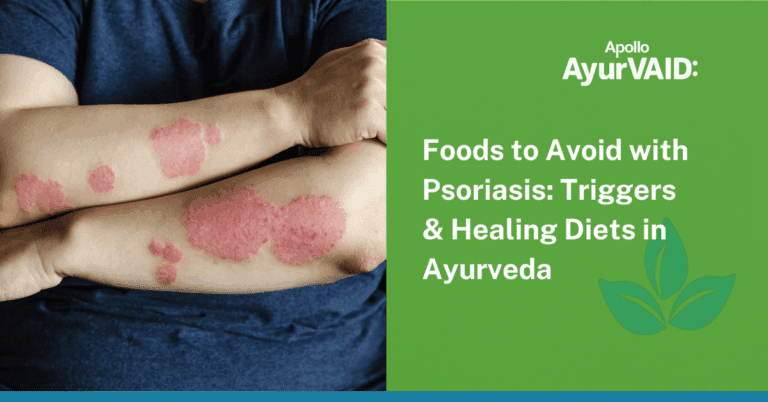Introduction
Sciatica afflicts millions globally. The pain slowly spreads from the lower back through the buttocks to the leg. In Ayurveda, this condition is referred to as Gridhrasi. Compression or irritation of the sciatic nerve, the longest nerve pathway in the body, results in sciatica.
What causes sciatica pain? The causes include herniated discs, spinal canal narrowing, poor posture, and trauma-producing pressure on the nerve roots. Sufferers of this condition would often wonder what causes sciatica buttock pain. Usually caused by piriformis muscle spasm or tight gluteal muscle compression, this would happen while the nerve traverses the buttock area.
Knowing the signs and symptoms of sciatica is important for an accurate diagnosis. This blog will explore effective treatment modalities for sciatica pain through Ayurveda, which comprises personalized approaches with internal medicines, external therapies, specialized procedures, and dietary modifications. These modalities address symptoms and root causes and provide sustainable relief.

What Causes Sciatica Pain?
Sciatica is considered Gridhrasi in Ayurveda, a condition in which pain may arise from the compression or irritation of one of the five spinal nerve roots or the sciatic nerve. The involvement of the sciatic nerve can affect either one or both legs.
Important Causes
- Herniated Disc: The soft inner material of a spinal disc leaks out through a tear in the outer layer, causing pain, numbness, tingling, or weakness, most often in the lower back, thereby leading to sciatica.
- Spinal Canal Narrowing: Degenerative changes, bone spurs, ligament thickening, or disc bulges narrow the spinal canal. As a result, symptoms like limping manifest (leading to sciatica), which worsen with walking or standing.
- Poor Posture: The piriformis is a deep buttock muscle that can become tight, spastic or irritated because of poor sitting posture, compressing or irritating the sciatic nerve and causing sciatica.
- Injury: Pain, dysfunction, and muscle imbalances can result from traumatic injuries and can cause persistent sciatic symptoms from nerve compression and inflammation.
According to Ayurveda understanding, Gridhrasi is primarily due to an imbalance of Vata Dosha, being classified as one of the 80 types of Vata imbalance disorders. Several etiological factors can aggravate Vata and lead to sciatica:
- Dietary factors: Intake of Vata-aggravating foods such as pigeon pea, Bengal gram, peanut, red lentil, and flat bean, excessive consumption of dry, light, cold, pungent, bitter, and astringent foods.
- Lifestyle factors: Heavy weight lifting, long walks, improper lying or sitting positions, and suppression of natural urges like urine and feces can contribute. Improper enema or purgation, excessive sexual indulgence, sleepless nights, riding vehicles, and heavy exercise are also listed as unwholesome habits. Sedentary lifestyles and jerky movements are also implicated.
- Trauma and injury: A fall or injury can be a direct cause. Direct trauma to the lumbar-sacral vertebra can lead to aggravated Vata in the lumbar region, affecting the lumbar joint and bones.
Vata can get vitiated due to Dhatukshaya (tissue depletion) and Margavarodha (channel obstruction). Conditions causing weakness in a specific area in the Kati (waist), Sphika (buttocks), and Prishtha (back) due to mild but continuous trauma, improper posture, jerky travel, heavy loads, or spinal cord injury can predispose to Gridhrasi.
Sciatica Signs and Symptoms
The symptoms of Gridhrasi (Sciatica) can be compared to sciatica, which involves radicular pain in the peripheral nervous system. The common signs and symptoms include:
- Pain: This typically begins from the buttock and then extends down the lower limb in the posterior or lateral aspects of the lower extremity, often covering the distribution area of the sciatic nerve. A radiating pain from the waist up to the knee, calve, and foot.
- Pricking sensation: Intermittent pain that feels like pinpricks spread along the same course as radiating pain.
- Stiffness: The knee and legs stiffen, restricting leg extension and causing difficulty lifting them.
- Twisting in the gluteal region: One may also experience throbbing pain.
- Numbness: Muscle weakness and a sensation of the affected leg being pricked with needles.
- Uneven gait: A patient often walks haltingly, taking short, slow steps with one side of the body bent and the affected leg (in a flexed position) resembling vulture-like walking.
The straight leg raising test (Sakthikshepa Nigraha) is a common diagnostic tool where leg lifting causes pain.
Treatment for Sciatica Pain
Ayurveda offers various modalities for the effective treatment of Gridhrasi (Sciatica). The treatment plan is individualized according to the person, the pathological condition, and the status of the Doshas. An all- inclusive aspect of Ayurveda is with minimum side effects, aiming at individualized treatment according to the condition and Dosha status of the patient. The primary aim is to relieve pain and other allied conditions.
The treatment categories under Ayurveda for the above conditions are as follows:
Internal medicines includes
- Deepana and Pachana Aushadhi (to improve digestion)
- Vata-Kapha pacifying medicines
- Gritha (medicated ghee) and Taila (medicated oils) for internal administration.
External therapies includes
- Snehana (oleation) through Abhyanga (massage)
- Murdha Taila Prayoga (application of oil on the head)
- Parisheka (pouring medicated liquids), Pichu (application of medicated pads)
- Kati Basti (retention of medicated oil over the lower back).
- Swedana (sudation) therapies such as Sarvanga (full body), Nadi Swedana (fomentation using steam pipe), Pizzichil (oil pouring followed by massage), wet and dry sudation, Patrapinda Sweda (fomentation with medicated leaves), Upanaha (poultice), Avagaha Sweda (tub bath), and Baluka Sweda (sand fomentation) are also employed.
Surgical procedures includes
-
- Sira Vedhana (bloodletting by puncturing)
- Agni Karma (cauterization therapy)
- Viddha Karma (puncturing) similar to acupuncture
- Pracchana Karma (bloodletting by multiple incisions
- Raktamokshana (bloodletting) is considered a potent treatment for eliminating aggravated Doshas and relieving pain instantly.
Panchakarma treatment modalities are crucial in managing Gridhrasi.
- Ama (toxins) and vitiated Doshas are eliminated using Vamana (therapeutic emesis) and Virechana (therapeutic purgation), especially in Vata-Kaphaja Gridhrasi.
- Vasti (enema) is another significant internal therapy for pacifying Vata, particularly Niruha and Anuvasana.
Ayurveda recommends foods like red rice, black gram, pumpkin, brinjal, chicken, and goat meat and drinks like coconut water, milk, and warm water in your diet. It also considers many foods like Chana, maize, barley, lotus stem, betel nut, cold water, cool drinks, dry, excess spicy, bitter, and pungent foods, which have aggravating properties of Vata, to be avoided. Pathya and Apathya (wholesome and unwholesome) depend on factors like quantity, time of consumption, processing, place, and individual constitution.
Conclusion
Ayurveda provides an all-inclusive approach to managing Gridhrasi (sciatica). The treatment strategy includes internal medicines such as Vata pacifying herbs, external therapies like specialized massage and oil applications, surgical interventions, bloodletting, and powerful Panchakarma purification treatments. To add to these, dietary recommendations are made that lead to Vata pacification. This comprehensive approach alleviates pain and addresses the root cause, providing the patient with a unique minimal adverse effect and preventing disease progression.

References
- De Silva UMG De Silva, Bapat V, Vedpathak SM, Attanayake AMHS. Management of sciatica (gridhrasi) through ayurvedic interventions – a literary review. Int J Alter Comple Medi. 2022;3(1):10-16. doi: 10.46797/ijacm.v3i1.318.
- Bandhe S, Sharma A, Gajendra R. A ROLE OF PATHYA AAHARA AND VIHARA IN THE MANAGEMENT OF GRIDHRASI W.S.R. TO SCIATICA. IAMJ. 2019;7(2):227-231.
- Patil NJ, Patil D, Tekur P, Venkatarathnamma PN, Manohar PV. Sciatica (Gridhrasi) – An Ayurveda Perspective. J Ayurveda Integr Med Sci. 2017;2(05):102-112. doi: 10.21760/jaims.v2i05.10264.
- Maneeri, A, Deep, C (2019). Management of Sciatica through Ayurveda- A case report. Journal of Research and Education in Indian Medicine (Est.1982) https://doi.org/10.5455/jreim.82-1504839882
- Belsare, M B et al. (2023). AYURVEDIC MANAGEMENT OF SCIATICA (GHRIDHRASI) W.S.R. TO LUMBAR DISC HERNIATION – A SINGLE CASE STUDY. International Ayurvedic Medical Journal. https://doi.org/10.46607/iamj4311062023
- Yadav, P, Sg, V (2022). AYURVEDIC MANAGEMENT OF GRIDHRASI WITH SPECIAL REFERENCE TO SCIATICA: A CASE REPORT. Journal of Biological & Scientific Opinion. https://doi.org/10.7897/2321-6328.105164





